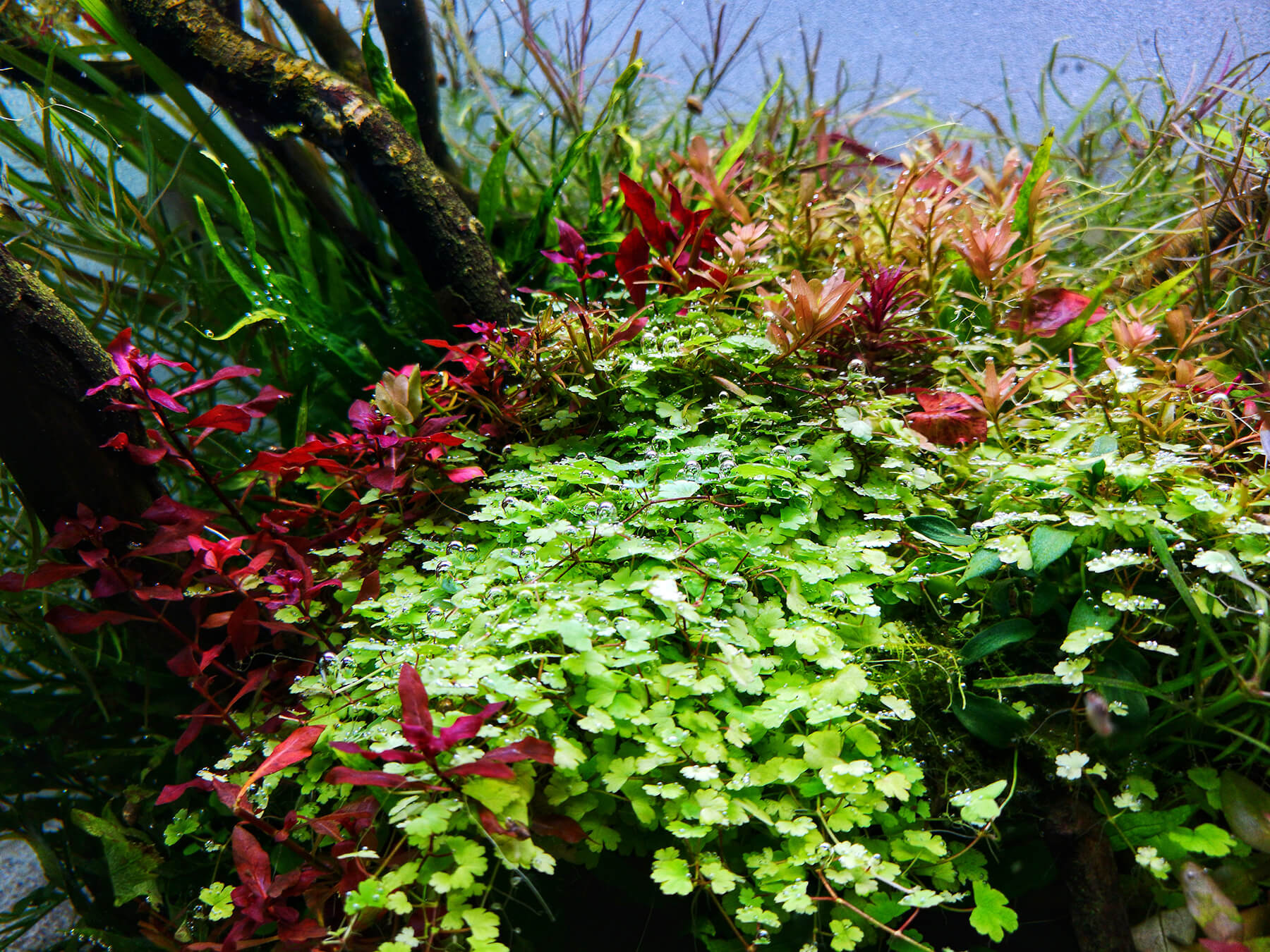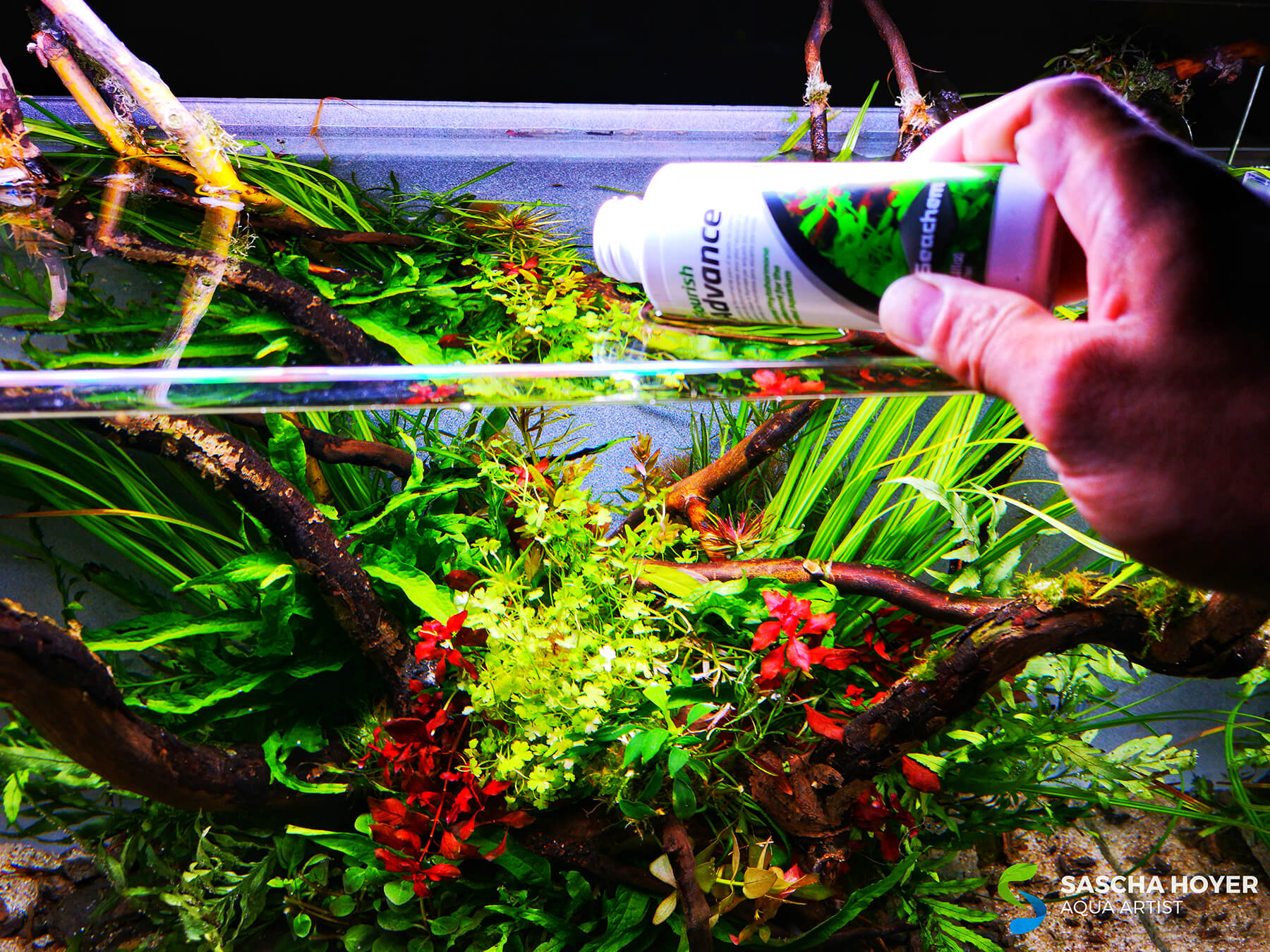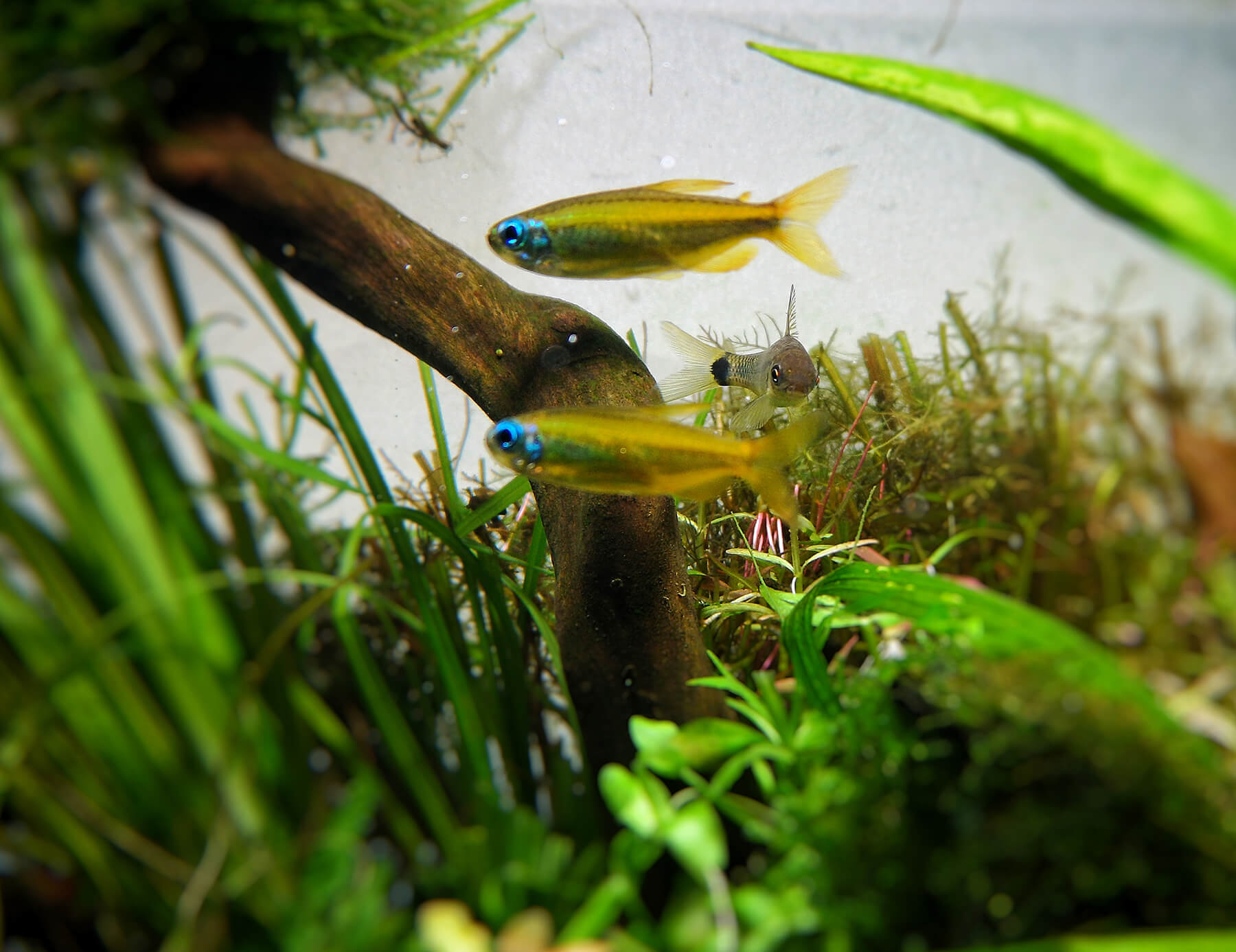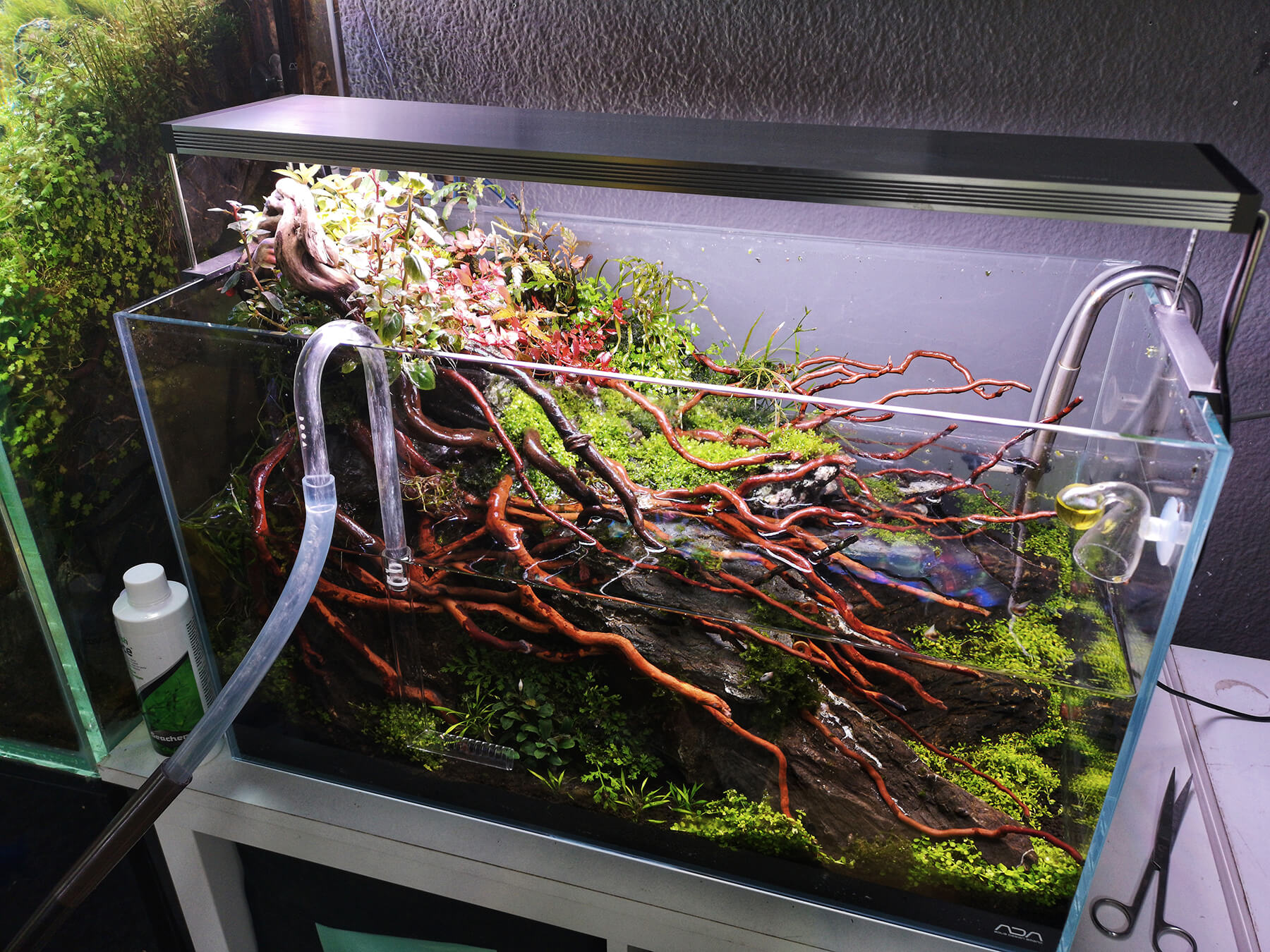The low-maintenance aquarium - is it possible at all or is it a myth?
Table of contents
- Preventing algae with healthy plants
- Algae prevention and disease prophylaxis - the animal population
- The right feeding for fish and invertebrates in the aquarium
- Choosing the right fish stock for an easy-care aquarium
- The clean-up crew - shrimps, snails and other algae eaters
- The technology in an easy-care aquarium
- What regular maintenance is required in a low-maintenance aquarium?
Many people have the prejudice that an aquarium requires a lot of work if it is to look reasonably nice. Most people think of an aquarium from the 1970s, with very coarse gravel, a few sparse plants that are more or less hanging on, a lot of mulm, plastic decoration (or even a bubble decoration, a small chest, etc.), a small chest from which bubbles might rise), lots of different coloured fish in all sizes, a snail population explosion(or alternatively, to avoid this, no snails at all), a somewhat dull spotlight above and a filter that roughly stirs the broth in the tank. And algae, preferably brush algae. Lots of them. Among the fish, a few algae eaters cavort to keep the splendour somewhat in check, no matter what size the tank is. Often the pretty fish are also fed very generously. Fish often fall ill and have to be replaced.
Such an "aquarium from hell" has to be maintained with a lot of effort, that is true. No biological equilibrium can develop here, and the whole set-up favours algae growth and the formation of mulm as well as bacterial films - and promotes diseases among the inhabitants. A major cleaning is definitely due at least twice a year, during which the chaos is brought back into order, so that you can look at it again for a few months without getting a bad feeling straight away.
But there is another way! A cleverly set up tank with cleverly selected inhabitants that match each other's needs and the aquarium can reduce the maintenance work for the aquarium owner to a minimum and at the same time looks much, much nicer than a siff tank. Biological balance is the magic word here!
Algae prevention through healthy plants
Algae are unfortunately the order of the day in an incorrectly stocked aquarium . This leads to nutrient imbalances that weaken the aquarium plants and strengthen the algae. Healthy plants are the enemy of all algae in the aquarium, and a well planted tank that is in balance usually has little to no algae problems. The choice of aquarium plants plays an important role in this. Only if the plants can grow healthily in the first place are they strong enough as a counter to the annoying algae.

Choosing the right plants
There are a few things to consider when choosing the right plants for your aquarium: Is the lighting strong, medium or weak? Is there CO2 fertilisation at the aquarium or not? Very sensitive or demanding plants need quite a lot of care to look good - can and do I want to afford that as an aquarium owner? Also in the long run? Then you choose the plants you want.
To start with, a few robust, fast-growing aquarium plants are highly recommended to draw the excess nutrients out of the water. When the actual aquarium plants have adapted to the new conditions and start to grow, the fast-growing plants can be gradually reduced (if you want - some of these plants actually look very nice).
Floating plants are also very helpful as nutrient feeders. Caution: Floating plants should never cover the entire water surface if you have light-hungry plants in the aquarium. A nylon thread closed into a ring and attached to a suction cup can help to keep the floating plants in check so that they do not leave their designated area.
Separate fertilisation with CO2 is not necessarily needed for all aquatic plants. If you do not want to operate a CO2 system in the aquarium, you should make sure when choosing plants that they do not require a high CO2 level in the aquarium. 10-15 mg/l would be the upper limit. Here in the shop we note for each aquarium plant whether CO2 fertilisation is necessary or not.
It would also be important to know whether you want to run the aquarium with rather hard, medium-hard or soft water. For the sake of simplicity, many aquarists use tap water. You can easily find out the water hardness on the website of your water supplier. The aquarium plantsshould then be selected accordingly. Plants that prefer soft water will not grow as well in hard water - and vice versa.
Another criterion for plant selection is light. Plants that need a lot of light take care of themselves in low light and do not grow well. They look spindly and unattractive and offer no competition to algae. For this reason, it is really important to know the illuminance of the aquarium lighting and to select aquatic plants accordingly.
If you pay attention to the needs of aquarium plants, nothing will stand in the way of a beautiful, green, lush living ecosystem. They stand up to algae and prevent algae plagues from occurring in the first place. In addition, healthy, vigorous plants produce the important oxygen for the aquarium animals through photosynthesis.
The right plant fertiliser in an easy-care aquarium
A good aquarium fertiliser is definitely an advantage if you want to maintain a beautifully planted aquarium. Water tests provide information about the nutrients available in the aquarium, so that you can fertilise any missing "food" for the plants without other substances accumulating in the water. With time, you will get a feel for the fertilisation ; for the beginning, it is definitely advisable to check now and then with a water test whether everything is still correct.

Algae prevention and disease prophylaxis - the animal population
The animals in the aquarium are another important factor for a stable ecosystem that is in balance. Too high a stocking level is more harmful than a low stocking level, because the excrements of the animals put a great strain on the filter. Of course, you should not only pay attention to the water hardness requirements for aquarium plants, but also when selecting fish and invertebrates for the aquarium!
The right feeding for fish and invertebrates in the aquarium
A very abundant feeding with inappropriately composed food (fish flakes or granulates of inferior quality with many fillers such as bakery waste, cheap fish meal, etc.) can promote not only algae growth but also bacterial growth, which in turn can lead to diseases in fish and invertebrates.
In addition, inappropriate feeding often leads to snail infestations in the aquarium due to an over-supply of nutrients. It is better to choose the stocking level of fish in the aquarium rather carefully and to feed them with species-appropriate, high-quality food.
In addition to frozen food or live food , a sensibly composed dryfood(flakes, tabs or granules) that is adapted to the needs of the fish species and invertebrates kept in the aquarium is also suitable for species-appropriate feeding of the fish and invertebrates in the aquarium. Here, too, the rule is: it is better to feed sparingly and a little more often than to feed a lot once and then not at all for a long time.
Choosing the right fish stock for an easy-care aquarium
At first glance, a colourful "fish soup" in the aquarium may appear varied and - yes, colourful ... but if you know that these fish can never behave in a species-appropriate way because they don't have enough conspecifics, you will still try to avoid them.
If you still like it colourful and varied, you can use different colour varieties - Guppies, Platies, different barbs , Mollies and many more are available in many different colour varieties, which allow you to stay within one species and give the animals a more species-appropriate life than in a colourful mix of species.
As a general rule, all regions of the aquarium should be stocked evenly with fish - the bottom, the middle zone and the zone below the water surface. This way the fish do not annoy each other - each occupies its niche and has its peace.

The clean-up troop - shrimps, snails and other algae eaters
Many fish are often touted as algae eaters - the catch is that most of them do not fit into smaller community tanks because of their demands on the size of the aquarium. It is better to avoid algae problems in the first place through clever planting and stocking, sensible feeding and appropriate fertilisation.
Many aquarium snails and dwarf shrimps not only take care of emerging algae growth, but also of food left over by the fish in the community aquarium - the small invertebrates may not be indispensable as a cleaning troop in the aquarium, but they can make life considerably easier for the aquarium owner!
Whoever is now crying out in warning of a snail plague - there are only as many snails as the food conditions in the aquarium allow. A strong increase in snails tells us as responsible aquarium owners that we have too many nutrients in the system - either through too much food, through low quality food that the fish cannot digest easily, through rotting plant remains, deceased aquarium animals that are lying somewhere and are being used by the snails, ... so we have to find the cause and remedy it. Then the number of snails in the aquarium will level out again.
Aquarium snails that feed exclusively on algae films, such as racing snails, limpets and staghorn snails, are not suitable for fresh tanks. They should only be introduced after a few months, when the aquarium has been run in and the system is stable. Only then will there be enough growth for them to use. Before then, you run the risk of the animals simply starving to death.
The technology in the easy-care aquarium
In terms of technology, we can also make life easier for ourselves in aquaristics. Today there are powerful, highly effective filters for every size of aquarium, from nano aqu ariums to giant tanks. Automatic fertiliser systems, automatic feeders, automatic CO2 systems with dosing computers, automatic heaters, even automated systems for effective water changes and many more gadgets are available.
The aquarium filter
But you don't necessarily need all these things if you're not that tech-savvy - well, except for the filter , of course! A well-equipped aquarium filter is half the battle. It not only mechanically removes turbidity from the water, but also eliminates pollutants. This job is done by filter bacteria that settle in the filter media inside the filter and do nothing else all day but simply eat up water pollutants from fish food, faeces and other waste.
Whether you choose an external filter, an internal filter or a backpack filter, a hamburger mat filter or an airlift filter is actually mainly a question of personal preference, space in and around the aquarium or in the aquarium cabinet. Modern filters are always effective. Of course, their specifications must fit the aquarium size!
The heater
If the stocking requires it, you will of course need a heater for the aquarium. Modern electronic heaters with automatic switch-off have proven to be very effective - the conventional technology based on bimetal switches is unfortunately relatively error-prone. It is essential to monitor the heater output with a thermometer, which is placed in the water inside the aquarium.
What maintenance work is regularly required in a low-maintenance aquarium?
Daily maintenance
Daily, of course, we feed and observe the fish and invertebrates in the aquarium. Are the animals fit and healthy? Do they eat well? Do they show intense colours and lively behaviour? If yes - great, everything is going well! If no - by checking daily, you can catch many problems as they arise, before things get really bad and there may even be losses of stock.
Of course, you should also take a close look at the aquarium plants. Are they all right? Any holes, spots, discolouration, fading? No? Great. Yes? Now it's time to look for the cause and correct the problem. If you have decided to fertilise your plants daily , you will of course also fertilise your aquarium plants daily.
The aquarium technology is also briefly examined: Is the filter running? What does the aquarium temperature say? Here too: problem recognised, problem solved.

Weekly maintenance
Once a week, we change between 10 and 50% of the water in the aquarium. In this way we prevent nutrient build-up in the aquarium water, which would then again promote the formation of algae.
During the water change, we take the opportunity to trim aquarium plants that have grown too large and replant them if necessary. We remove dead plant remains, vacuum the substrate , remove mulm accumulations from the corners and clean out the plants.
It also doesn't hurt to clean the inside of the glass at the same time. By the way, many shrimp keepers and aquarium snail fans only clean the front glass and leave the rest of the glass to become algae-covered, because the shrimp and snails find extra tasty food there in the form of growth, and at the same time it's a great place to watch them eat.
If you want to fertilise the aquarium plants on a weekly basis, fertilise accordingly (of course AFTER the water change) with aquarium fertiliser according to the instructions on the package.
Maintenance work that only needs to be done from time to time
When the filter becomes clogged and less water comes out of the filter outlet, the filter media must be cleaned. To do this, it is sufficient to squeeze them thoroughly in a bucket of aquarium water. Even if the manufacturers claim otherwise: filter media do not have to be replaced every few weeks - they can remain in the filter for several years with good maintenance.
Because you reduce important bacteria when cleaning the filter, you should feed very sparingly for a day or two after a major filter cleaning.
That's really all there is to it. If you set up and plan your aquarium wisely, you can safely do without jokes like "everything has to be removed once a year, including the substrate". An aquarium that is carefully set up and stocked can run stably for several years without major rearranging and cleaning and still look smart and well-maintained with little effort.
